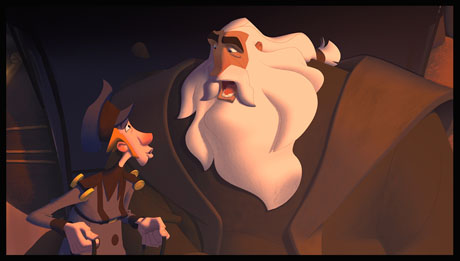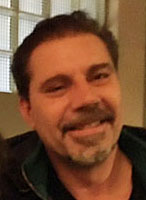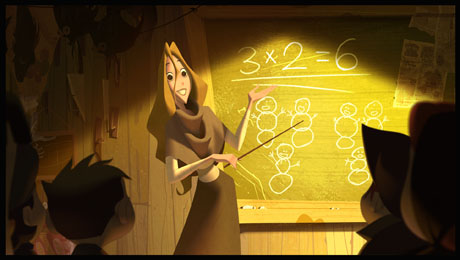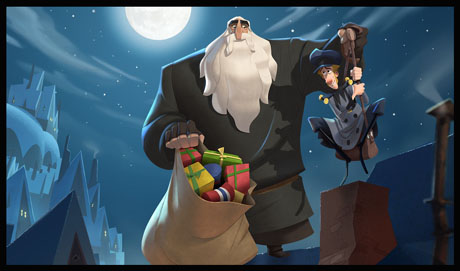
The holiday season is in full swing with the new animated movie Klaus. It’s in select theaters this weekend and debuts on Netflix Nov. 15. Longtime animator Sergio Pablos (The Hunchback of Notre Dame, Tarzan) makes his directorial debut. He shares his vision of a new take on the Santa Claus story.
Sergio Pablos: I thought I found an angle to tell it in a different way. I thought that if I could find this angle that could make the story not sappy but witty and ironic, but also have a heart – that would be the way to go about it. I started playing with these ideas and thought maybe Santa is not our main character. How about we make this postman guy our main character – someone who needs to learn a lesson about altruism. And I started discovering that this really led itself to an interesting story, so that’s why I went for it.

Jackson Murphy: You’ve got Jesper the mailman, voiced by Jason Schwartzman. What made him right for Jesper?
SP: Well, he was actually essential to the role because we took a while to find the character. I’ve been in movies before where you have your main character be one of these morally reprehensible characters filled with flaws. And then you run the risk that the audience may actually not like him. And if they don’t like him, they will not go along for the ride with him. So we had to find the sweet spot. Even though we have a character who’s at face-value not likable, he still has to be likable. And that’s when Jason came in. We… tried to find the character, but he was the one that literally found that sweet spot, and he made it work. Jason was great. He was a great improviser. A lot of the lines that ended up in the film were not scripted. He just went with it, and we ended up finding way better stuff to work with by working with Jason.
JM: And when it comes to J.K. Simmons: he’s got that deep voice. He can be sinister or kind depending on the role. When it comes to the character of Klaus, I was surprised by some of the dramatic elements. Was he surprised by them as he was reading the script and figuring Klaus out?

Sergio Pablos
JM: That’s great to hear. You also cast a lot of child actors. Some of my favorite scenes in “Klaus” involve kids getting excited about writing the letters to Klaus and getting excited about receiving the toys. How was it casting the child actors and working with them?
SP: The credit goes to our casting director, who did a fantastic job finding that good range of children from several ages. I couldn’t always be present in the room. Sometimes we had to do the recordings remotely from Spain. So we had to rely on the great aid of Kelley Whitis, who was handling the children and making sure she got the right energy from them. I’ve worked with children characters before that were voiced by adults because it’s sometimes easier. But I just really wanted it to sound authentic. And we recruited as many kids as we could. Even my own kids are there. (laughs) Whatever worked! And we’ve been told that children work particularly well as voice acting, which is great.
JM: So this story is about Jesper, who goes to this very remote town and – the spirit of Christmas is there through his actions and Klaus. I’m curious to know how personal this story is, and how much you relate to the characters in the film.
SP: I think they all have something of me in them. The underlying theme is happiness. At face value it is kindness. Kindness is the message we’re trying to convey. What we have is a range of characters that all have a different relationship towards happiness. Jesper is someone who starts as a spoiled young kid who’s always had it easy in life. And he actually had places his happiness in the luxury around him… what he owns. He needs to learn a lesson that happiness is in giving, not having. Klaus is a character who knew happiness and lost it – and took himself away from the world. And we spend a good length of this film showing how he gradually comes out of it. He eventually becomes something closer to the Santa we are expecting.

Rashida Jones plays Alva, who enters this town to be a teacher and then she found out that nobody sends their kids to school in this place. And she lost hope of being that teacher she wanted to be. We do also see how she transforms and finds that happiness. And the klans, who perpetually fight in this town, find happiness in making others unhappy. So it was all about “How I do transform all of these arcs throughout the film and weave them in an interesting way?”
JM: And I’m really glad we take it from this delivery service/mailman perspective. Ever since I was young, I loved getting mail. I still love receiving mail/packages. I’m glad you’ve got that in this film – and incorporating the idea of children being able to physically write a letter to Santa Claus.
SP: Thank you. That was an important part of the film – to make sure that the power of communication was present, and mail was our symbol to it.
JM: You are a 2-time Annie Awards nominee for character animation and design. I wouldn’t be surprised if you were back on the ballot this year for Klaus. What were some of your goals for the looks of Jesper and Klaus?
SP: You can see that there’s a heavy influence of Disney films in this one because I spent a long time working for Disney. So their style became part of my own style… But it was more than a choice. That’s what I do. It’s my style. And then I recruited the help of others to shape it. The design for Jesper came by very quickly. I did a quick doodle, expecting it to be the first of many. But it seems like the team liked it and went along with it, so it never really evolved farther from that.
Klaus – we actually got several designers for that character, just trying to find that perfect version of Santa that’s not exactly what you would expect. We wanted somebody tougher. We wanted somebody who, at first glance, would be more intimidating. But we wanted to capture the soul inside of his eyes, which took a long time to figure out how to make them expressive and show the audience there’s more than meets the eye with this guy.

JM: And the majority of this movie is hand-drawn, but it’s not the kind of hand-drawn like when you worked at Disney in the ’90s. How did this animation truly come together?
SP: Well you’d be surprised to know a lot of it is exactly like those films. Most of it is actually done exactly the same way. The illusion is that we’re no longer working on paper, we work on digital tablets. But it’s still the same process. What we did is we asked the question, “How could we integrate characters and backgrounds for the first time in a seamless way? – so it did not seem like in the past… that they were not done by the same hand. We realized that a big part of that was the light. The light that affects the background needed to affect the characters the exact same way. So we went about developing tools to be able to allow artists, not computers, but artists to put light on top of moving images. And it’s a very manual process, but it’s also aided by great technology. It turns out that people who already know how to paint light only needed the right tool to be able to do it, and that’s what we gave them.
JM: And when it comes to the action sequences and chases, they’re sort of “Looney Tunes”-esque. Are there some “LT” influences in those scenes?
SP: I’m sure, unconsciously, there’s plenty of it. I’m old school. There’s definitely a bit of slapsticky, especially with the klans, the antagonist characters. They allow themselves… they lend themselves to it. Whenever we saw an opportunity for broad comedy, we would use it.
JM: So Sergio, what do you really want for Christmas this year?
SP: I want this movie to be seen by as many people as possible. That’s really the biggest wish that we have right now. It was a labor of love over 9 years. And I can’t wait to finally see it come to the audiences. So far we’ve had the opportunity to watch the reaction at a few advance screenings, and it’s been very encouraging. So I’m really hoping people will connect with it.
JM: Wow. 9 years. 9 Christmases you’ve gone through. Is this gonna be the most relieved one of them all over the past 10 years or so for you?
SP: Hopefully it will be!
- INTERVIEW: “Inside Out 2” Director And Producer On Pixar Sequel - April 16, 2024
- INTERVIEW: “Puffin Rock And The New Friends” And 25 Years Of Cartoon Saloon - April 10, 2024
- INTERVIEW: “Chicken For Linda!” Directors On Annecy Winning Feature - April 9, 2024


 November 7th, 2019
November 7th, 2019  Jackson Murphy
Jackson Murphy  Posted in
Posted in  Tags:
Tags: 






